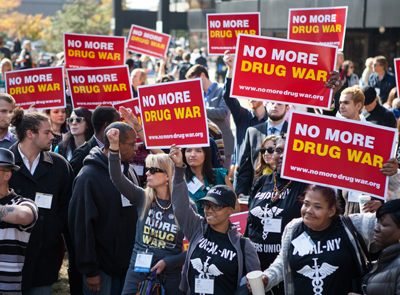Drugs and the ‘War on Drugs’: Weapons against workers and oppressed
The history of the use of drugs — legal and illicit — against the working class and its movement is a long one. The “War on Drugs” — officially declared on June 17, 1971, but a staple of U.S. policy since the 1950s and amplified in 1973 — really acts as a war on drug users. There have been multiple drug abuse and overdose epidemics from the 1950s onward. Neither the drug users, nor the working class as a whole, were prepared for the problem of drugs being socially used as weapons — or as a means to get free (slave) labor by expanding mass incarceration.

Employment of drugs as a weapon to stifle the discomfort and discontent and thus destroy proletarian movements in the United States is a large subject. With the rise of the Black Panther Party and the antiwar movement in the 1960s and ’70s, President Richard Nixon (who despised Black and Brown people, left wing organizations and movements, drugs and drug users) aimed to use his War on Drugs to eliminate his political enemies on the left.
Nixon’s White House Counsel John Erlichman said that the president “had two enemies: the antiwar left and Black people” and that because he couldn’t directly criminalize being antiwar or being Black that he would “[get] the public to associate the hippies with marijuana and Blacks with heroin,” in order to “arrest their leaders, raid their homes, break up their meetings and vilify them, night after night, on the evening news.”
In 1973, the Nixon Administration founded the Drug Enforcement Administration, supposedly to find and destroy sources of drugs inside and outside U.S. borders. This was merely a prelude to the full horrors of “anti-drug” actions in the U.S. The DEA at the time of its founding was 1,500 agents strong, with a budget of $75 million. By 2016, the DEA had more than double the number of agents and a budget in the billions.
In 1982, the Reagan administration was appealed to by wealthy business owners from Miami-Dade County, Florida. They were demanding aid in fighting the drug problem, which had resulted in hundreds of violent deaths. Government agencies — the DEA, IRS and FBI among others — were showing up to arrest anyone involved or suspected to be involved with drugs. Under Ronald Reagan, the Office of National Drug Control Policy was founded.
Laws target the most oppressed
In 1986, the basketball star Len Bias went to a party where he was given cocaine, which killed him just as he was celebrating his successes. After this case and other drug-related deaths and murders, New York Rep. Charles Rangel worked with Reagan’s administration to pass the Anti-Drug Abuse Act of 1986, which turned out to be one of the strictest laws passed during the War on Drugs era.
This law was supposedly color-blind, putting drug dealers away and keeping the communities drugs were ravaging safe. In reality, the state was charging Black and Brown men at a rate higher than white people. While drugs were a scourge, it was not Black or Brown men selling cocaine. Cocaine was being sold by white people primarily to white people, with some exceptions like Len Bias.
Future President Joe Biden was partly responsible for one of the most obviously racist aspects of the War on Drugs: the sentencing disparity between selling powder cocaine and crack cocaine, with the harsher penalty for crack. White people were more commonly users of powder cocaine, particularly petty bourgeois white people. But the crack cocaine because of its low price was pushed into communities to be used by Black and Brown people.
The U.S. government has contributed to the spread of cocaine use in this country. As early as 1984, the United States knew that there were Contras — right-wing anti-Communist, anti-Sandinista fighters in Nicaragua — who were either trafficking cocaine themselves or aiding other trafficking rings in Latin America. And the U.S. State Dept. funded the Contras.
The War on Drugs included federal laws that increased mass incarceration; similar laws existed on the state level. In New York State, then-Governor Nelson Rockefeller established the Rockefeller Drug Laws, which established varying sentences for possession of drugs over a certain level. While these laws were eventually altered to remove the mandatory minimums of sentencing, it was after the damage had been done. Thousands of young, nationally oppressed people were locked behind bars because of Rockefeller’s “tough on crime” stance.
This is only a short summary of the impact that the War on Drugs and drug use itself has had on the working class. The entire history would fill many volumes. But knowing the basics can help to resist the continued War on Drugs.

